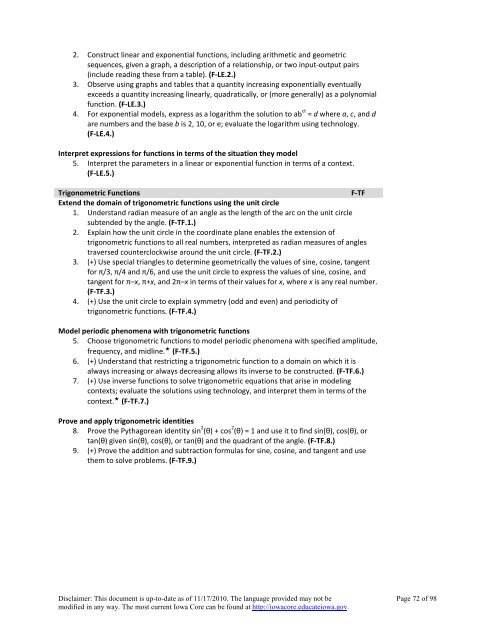Iowa Core K-12 Mathematics (PDF) - Green Hills AEA
Iowa Core K-12 Mathematics (PDF) - Green Hills AEA
Iowa Core K-12 Mathematics (PDF) - Green Hills AEA
You also want an ePaper? Increase the reach of your titles
YUMPU automatically turns print PDFs into web optimized ePapers that Google loves.
2. Construct linear and exponential functions, including arithmetic and geometric<br />
sequences, given a graph, a description of a relationship, or two input-output pairs<br />
(include reading these from a table). (F-LE.2.)<br />
3. Observe using graphs and tables that a quantity increasing exponentially eventually<br />
exceeds a quantity increasing linearly, quadratically, or (more generally) as a polynomial<br />
function. (F-LE.3.)<br />
4. For exponential models, express as a logarithm the solution to ab ct = d where a, c, and d<br />
are numbers and the base b is 2, 10, or e; evaluate the logarithm using technology.<br />
(F-LE.4.)<br />
Interpret expressions for functions in terms of the situation they model<br />
5. Interpret the parameters in a linear or exponential function in terms of a context.<br />
(F-LE.5.)<br />
Trigonometric Functions<br />
F-TF<br />
Extend the domain of trigonometric functions using the unit circle<br />
1. Understand radian measure of an angle as the length of the arc on the unit circle<br />
subtended by the angle. (F-TF.1.)<br />
2. Explain how the unit circle in the coordinate plane enables the extension of<br />
trigonometric functions to all real numbers, interpreted as radian measures of angles<br />
traversed counterclockwise around the unit circle. (F-TF.2.)<br />
3. (+) Use special triangles to determine geometrically the values of sine, cosine, tangent<br />
for π/3, π/4 and π/6, and use the unit circle to express the values of sine, cosine, and<br />
tangent for π–x, π+x, and 2π–x in terms of their values for x, where x is any real number.<br />
(F-TF.3.)<br />
4. (+) Use the unit circle to explain symmetry (odd and even) and periodicity of<br />
trigonometric functions. (F-TF.4.)<br />
Model periodic phenomena with trigonometric functions<br />
5. Choose trigonometric functions to model periodic phenomena with specified amplitude,<br />
frequency, and midline. ★ (F-TF.5.)<br />
6. (+) Understand that restricting a trigonometric function to a domain on which it is<br />
always increasing or always decreasing allows its inverse to be constructed. (F-TF.6.)<br />
7. (+) Use inverse functions to solve trigonometric equations that arise in modeling<br />
contexts; evaluate the solutions using technology, and interpret them in terms of the<br />
context. ★ (F-TF.7.)<br />
Prove and apply trigonometric identities<br />
8. Prove the Pythagorean identity sin 2 (θ) + cos 2 (θ) = 1 and use it to find sin(θ), cos(θ), or<br />
tan(θ) given sin(θ), cos(θ), or tan(θ) and the quadrant of the angle. (F-TF.8.)<br />
9. (+) Prove the addition and subtraction formulas for sine, cosine, and tangent and use<br />
them to solve problems. (F-TF.9.)<br />
Disclaimer: This document is up-to-date as of 11/17/2010. The language provided may not be Page 72 of 98<br />
modified in any way. The most current <strong>Iowa</strong> <strong>Core</strong> can be found at http://iowacore.educateiowa.gov.
















